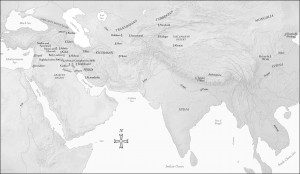Whether or not we like the fact, the fate of great religions is often shaped by political factors, by the rise and fall of empires and Great Powers. Just look for instance at the distribution of those thriving Catholic and Anglican churches across the former imperial possessions in Africa. When we write Christian history, though, one empire in particular often escapes our attention, and it provides a vast hole in the story.
Once upon a time, in the ancient world, there was a vast empire. Although it was at times deeply hostile to Christians, which it actively sought to suppress or exterminate, the fact of that empire’s existence provided an essential framework for Christian expansion. Christian communities flourished in the empire’s booming cities, which they made the seats of church organization. They also benefited from the stability and peace that the empire imposed, and the vast network of roads and sea communications that it sustained, not to mention its common languages. Where the empire stretched, there followed the churches. Ultimately, the empire faded and died, but the churches that had formed in that matrix survived and flourished, outlasting the empire for many centuries.
Such a phenomenon is of course very familiar in the Western world, which emerged on the ruins of the Roman Empire. As Thomas Hobbes famously remarked, “And if a man consider the original of this great ecclesiastical dominion, he will easily perceive that the papacy is no other than the ghost of the deceased Roman Empire, sitting crowned upon the grave thereof: for so did the papacy start up on a sudden out of the ruins of that heathen power.” But in this instance, I am not speaking of the Roman Empire, but of the vast eastern superpower that was its counterpart and deadly rival: the Sassanid realm of Greater Persia. Without that other empire – that empire in the mirror – the story of Christian expansion to the east, as well as the west, is incomprehensible.
Although the Sassanid Empire attracts plenty of fine scholars, it is much more difficult to find general histories of that state than the Roman Empire. Yet its achievements were deeply impressive. The dynasty lasted from 224 to 651, and stretched far beyond what we think of today as Iran, and deep into Central Asia. That was so critical because the Sassanids linked directly to the Silk Route, the world’s most important commercial artery at that time, and a crucial cultural channel, stretching from Syria to China. The Sassanid capital of Seleucia-Ctesiphon on the Tigris was in its day one of the world’s greatest cities, and the direct precursor of later Baghdad.
Also important for our story, Sassanid Persia fought deadly wars with the Roman Empire, and in the early seventh century came within an ace of utterly destroying the Eastern Roman world. Without those wars, Islam could never have gained the victories it later did.
The story of Christianity in the East also depends on Sassanid affairs. Yes, anti-Christian persecutions could be savage, under a realm that strictly followed the Zoroastrian faith. But Christians also used the imperial framework to expand into Central Asia, through what we now call Afghanistan and the “stans” of Central Asia, and into the Silk Route itself. Just look for instance at a map of the metropolitan sees of the vast Church of the East, the so-called Nestorians. Is that not a ghost of the Sassanid world?
I’ll be posting more about this lost dimension of Christian history, and the empire that we seem to have forgotten so completely.
















